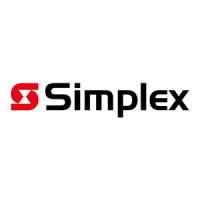b. The alphanumeric display shows the area and type of problem, as shown below.
FIRST FLOOR EAST WING
ROOM 31
Press <ACK> key to acknowledge
OR
I
FIRST FLOOR EAST WING
ROOM 31
FIRE PUMP MONITOR
RUNNING
3. Read the alphanumeric display. Then, investigate the supervisory service condition to determine its cause.
Restore or replace the defective equipment in accordance with equipment instructions.
NOTE:
When the Supervisory Service Condition clears, the SUPERVISORY SERVICE LED flashes and
the tone-alert sounds steady.
4. Press the &UPV ACK> key. The alphanumeric display shows the system status.
5. Press the cSUPV ACK> key again. After a delay, the alphanumeric display should show the following
message.
I
SYSTEM IS NORMAL
8:41:43
MON 7 DEC 92
ESSENTIAL SUPERVISORY SERVICE CONDITION KEYS
The essential keys for supervisory service conditions are cSUPV ACK> and the <SYSTEM RESET> keys. The
remaining keys are concealed by the access door and are associated with advanced functions of the system. (See
Section 9, Advanced Functions.)
SUPERVISORY ACKNOWLEDGE KEY
The &UPV ACKz key is used to scroll through the various data fields on the alphanumeric display. It also controls
the SUPERVISORY SERVICE LED and the tone-alert. The &UPV ACK> key is located directly under the
SUPERVISORY SERVICE LED. Pressing the &UPV ACK> key (w for Individual Acknowledge or once for
Global Acknowledge) causes the LED to change from flashing ON to steady ON, and silences the tone-alert. The
cSUPV ACK> key press does the following:
l
Selects the next unacknowledged supervisory point and shows it on the display (Individual Acknowledge)
l
Acknowledges the displayed point or acknowledges all points on the list (Global Acknowledge)
l
Scrolls the points chronologically after all points have been acknowledged.
NOTE:
The eSUPV ACK> key may be passcode protected. If you do not have the required access level, you will
not be able to acknowledge supervisory conditions. See Operator Access Levels (Section 9) and the Log
In Procedure (Section 1) for details.
There are two types of acknowledges for the NDU: Global Acknowledge and Individual Acknowledge. Each
acknowledge type operates with the Supervisory Service Condition in the following manner.
23

